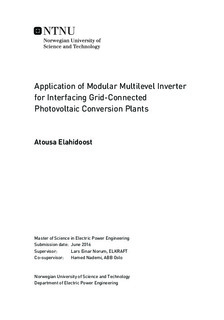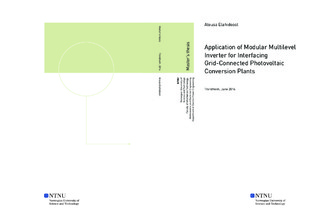| dc.description.abstract | The main focus of this master thesis is to investigate the application of modular multilevel converter (MMC) based grid-connected photovoltaic (PV) conversion systems, and a MATLAB/Simulink model of a PV system composed of two arrays connected to the grid via a five-level MMC is presented to study its operation under steady state and transients.
In response to global ever-increasing energy demand, and the pivotal significance of 100% clean and sustainable energy future to alleviate the adverse impact of fossil fuels and nuclear energy on global warming; tendency towards renewable sources of energy especially solar photovoltaic systems has incredibly grown in recent years. MMCs, as the PVs inverters and controllers, among their other competitors show superior characteristics and immense potential. The most significant one as the name implies is its modularity that giving rise to fault-tolerant and fail-safe functionality as well as improved waveform quality and reduced harmonic pollution. Besides, MMCs are capable of transformer-less operation; in other words, small passive filters can be the only elements linking these converters to the grid.
In this study, a model for MMC-based grid-connected PV applications using MATLAB/Simulink software is developed. First, a piecewise linear model of a solar cell for simulating grid-connected PV systems is utilized to evaluate dynamic and transient response. Then, due to intermittent nature of the solar cells under various irradiances and temperatures, two different maximum power point tracking (MPPT) methods are implemented and compared under steady state and transients. The first one is the simple, flexible and robust method of perturb and observe (P&O) where practical techniques for choosing the perturbation frequency and step size based on the selection of the MPPT transient time is introduced. The second strategy is ripple correlation control (RCC) which reduces the steady state error and improves the convergence time. Next, to balance submodule (SM) capacitor voltages and reduce voltage ripples of the MMC, a phase disposition pulse width modulation (PDPWM) technique based on selective virtual loop mapping (SVLM) is simulated that is much faster than the conventional sorting algorithm since it only demands for min and max SM capacitor voltages. Finally, a conventional control method based on modulus optimum technique for tuning of inner current control loop, and symmetrical optimum technique for tuning of outer dc-voltage control loop is presented. Besides, the non-linear method of internal model-based control (IMBC) for controlling the current is presented. In this regard, system dynamic performance under variations imposed by MPPT algorithms is improved, and the quality of the injected three phase current to the grid is enhanced. | |

